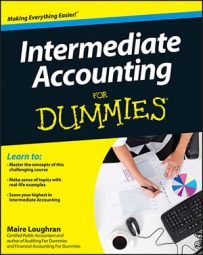You’re probably somewhat familiar with intangibles from other accounting classes you’ve taken. However, your intermediate accounting textbook takes a slightly difference approach to the discussion by dividing the two types of intangibles into six different categories: marketing, customer, artistic, contract, technology, and goodwill.
Marketing as intangible assets
These intangibles help promote the company’s goods or services. Your biggie marketing-related intangible asset is a trademark. These assets are unique signs, symbols, or names the company uses to create a brand or unique image. For example, think “Kleenex” versus “facial tissue.
If a company buys the trademark from another company, it capitalizes the purchase price. If the company develops the trademark itself, all costs relating to its development are capitalized, except for research and development costs.
If the costs to develop the trademark are immaterial, just expense them. What is material versus immaterial? Well, it’s all relative. What may be material for one company may be immaterial for another. For example, to a multinational company worth millions of dollars, $50,000 is probably immaterial. While the same amount is very material to a smaller company worth in the tens of thousands.
Customer-related information is an intangible asset
Your biggie customer-related intangible assets are customer lists and any other customer-related information. Every time you’re the (un)lucky recipient of an unsolicited credit card offer, you’ve been a hapless victim of the buying and selling of customer-related information. As you can probably guess, this asset is extremely lucrative.
So how do you account for it if the company purchases a customer list from another company? You first have to figure out the useful life of the customer-related asset. You also have to look into the future and decide whether your company will be able to sell the customer list to another company when it’s done with it. In other words, does the list have residual value?
Artistic-related intangible assets
Artistic-related intangibles include items such as copyrights, which protect ownership rights. In other words, someone can’t use the company’s printed work (books, poems, and the like) or recorded work (musical score, song lyrics, movies, and so on) without permission. Any original piece of work is automatically copyrighted.
Capitalize the cost to acquire a copyright and also the cost to defend it if some nasty plagiarizer starts using the material without permission. Then allocate the costs of the copyrights to its useful life.
Contract-related intangible assets
Contract-related intangibles include franchise agreements, licenses, and permits. For now, keep in mind that a franchise is a business that perhaps started out as a one-location shop but grew to be so popular that the original owners allowed other individuals to open shops with the same concept in other locations.
The parties to a franchise are the franchisor, the party granting the business rights, and the franchisee, the individual purchasing the right to use the franchisor’s business model.
Licenses and permits come into play when a government agency grants a private company operating rights, such as the use of city streets or designated areas for taxicab stands.
Expense the cost of acquiring a franchise over the life of the agreement. Expense annual franchise costs in the financial period in which the franchisee incurs them.
Licenses and permits are capitalized if the company can match the costs to obtain the operating right with the actual license or permit. Again, expense de minimis, or immaterial, costs when they occur.
If a company pays a minimum guarantee for the privilege associated with the license or permit, the amount of the guarantee records as an intangible asset and moves to the balance sheet over the life specified in the license agreement.
Technology as intangible assets
The biggie technology-related intangible is patents. A patent provides licensing for inventions or other unique processes and designs. Items that patents protect run the gamut from pharmaceuticals, to automobile circuitry, to unique machinery designs.
If a company purchases a patent from the inventor, the capitalized cost is the purchase price plus any costs incurred as part of the acquisition process, such as legal fees. Costs leading to patents developed in house aren’t capitalized, but are shown immediately as expenses on the income statement.
Unlike goodwill, these five categories of intangible assets are relevant to the day-to-day operations of just about any business.
Leasehold improvements, which are costs a company incurs when it leases its business location and updates the rental space with features it can’t take along at the end of the lease, are also considered to be intangible assets. In this situation, balance sheets prepared in accordance with generally accepted accounting principles (GAAP) lump leasehold improvements with PP&E.

